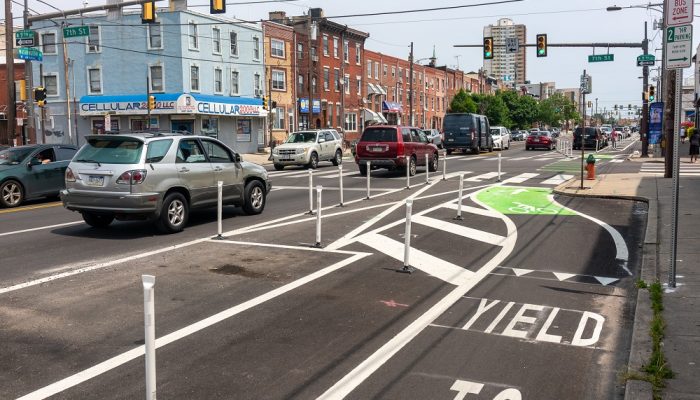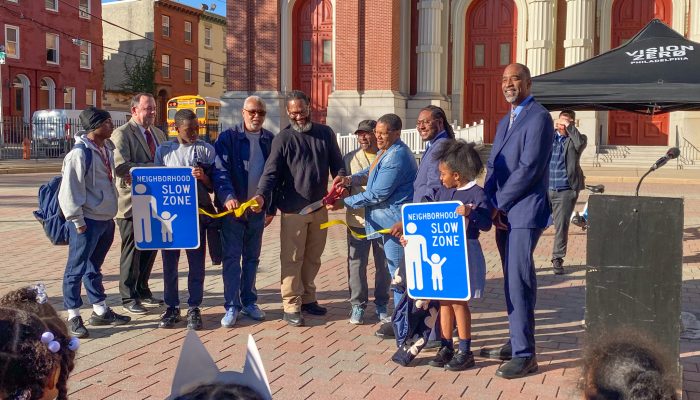Completed in 2023, the Washington Avenue Repaving and Improvement project aimed to improve transportation safety and implement better curbside management on Washington Avenue, primarily between Broad Street and 4th Street. The Office of Transportation, Infrastructure, and Sustainability (OTIS) carried out the community engagement and design processes while the Department of Streets oversaw the implementation.
Some of the key improvements between Broad Street and 4th Street included:
- Installing traffic calming measures,
- Reducing pedestrian and bicycle exposure to motor vehicle traffic,
- Increasing available daytime parking capacity,
- Installing new public loading zones, and
- Installing interim painted bus boarding islands.
Additional traffic calming, including speed cushions and hardened centerlines, was installed on specific blocks between Grays ferry Avenue and Broad Street.
The project was enabled by City Council legislation, which requires that OTIS complete project evaluation studies at the 1-year and 2-year marks following project implementation.
The purpose of this study is to collect data on Washington Avenue and parallel routes to understand how the project has impacted people walking, driving, taking transit, and riding bicycles on Washington Avenue. In the Washington Avenue Year 1 Evaluation Report, you can find comparisons between Washington Avenue east of Broad Street, which received a road diet with new parking and loading regulations, and Washington Avenue west of Broad Street, which received less significant changes.
Key takeaways
Washington Avenue is safer, greener, and more efficient following project implementation. There is significantly less speeding on blocks with new speed cushions, and the percent of people driving above the posted speed limit has decreased across the corridor.
The results of the Year 1 Evaluation indicate that Washington Avenue is more efficient for all users after the project, noting:
- Parking and loading capacity have increased on blocks with new timed parking regulations and loading zones since the project was completed,
- Instances of illegal parking have decreased significantly since the project was completed, and
- There were no significant operational impacts on vehicle travel times or transit operations where the Washington Avenue lane reduction occurred, or on parallel routes.
The results of the Year 1 Evaluation also indicate that Washington Avenue has become a greener roadway:
- Route 64 travel times have improved where the project implemented interim painted bus islands,
- Route 64 ridership increased at a faster rate than the citywide bus system, and
- More people are riding bikes on Washington Avenue, especially between 11th Street and 4th Street in the new parking-separated bicycle facility.
Peak hour bike volumes increased up to 181% on blocks with new separated bike facilities. Overall bike volumes increased between 62% and 101% on the full corridor from Grays Ferry Avenue and 4th Street.
Instances of illegal parking have decreased significantly on Washington Avenue between Grays ferry Avenue and Broad Street:
- Instances of double parking decreased by 87.9% from 2017 (before the project) to 2023 (after the project).
- Instances of median parking decreased by 74.9% from 2017 (before the project) to 2023 (after the project).
While instances of double parking and median parking have decreased significantly, sidewalk parking remains a persistent problem, especially on specific blocks This includes:
- Instances of sidewalk parking increased by 81% from 2017 (before the project) to 2023 (after the project).
The largest increases in sidewalk parking were concentrated on the 700, 800, and 900 blocks, corresponding with operating hours for auto and construction-related businesses at those locations. Anecdotally, sidewalk parking has increased across Philadelphia since the pandemic, but this remains a significant challenge to address on Washington Avenue.
What happens next?
The City will upgrade some of the interim painted bus islands to concrete in coordination with SEPTA, improving accessibility and making it safer and faster to get on and off the bus. Additional changes to signal timing, curbside regulations, and enforcement strategy will also be evaluated.
There will be another study completed in March 2025 to assess what conditions are like two years after installation. OTIS plans to complete a comprehensive 3-year post-installation crash analysis in Fall 2027.
In the meantime, the City will follow up with businesses to ensure that the project design is meeting their needs. We will continue monitoring conditions on the corridor to see if any changes need to be made.




